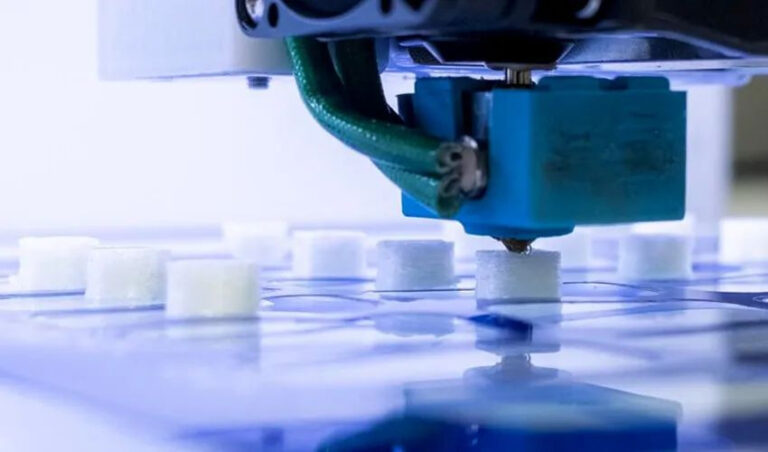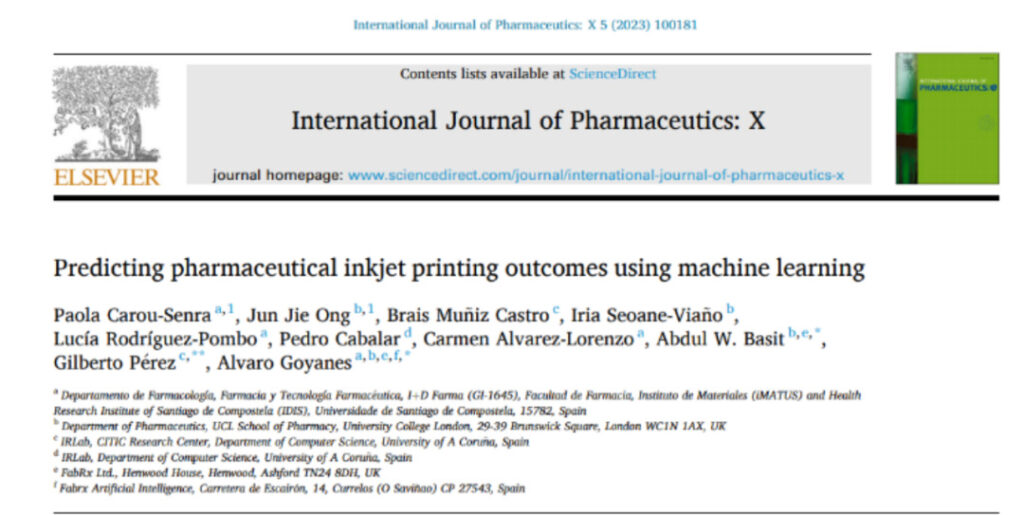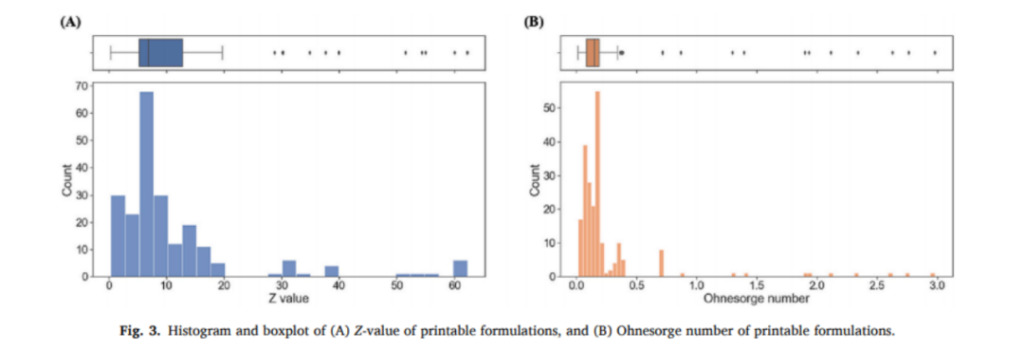Command Palette
Search for a command to run...
New Breakthrough in Drug 3D Printing: University of San Diego Uses Machine Learning to Screen Inkjet Printing bio-inks With an Accuracy Rate of up to 97.22%

Contents at a glance:Drug inkjet printing is a highly flexible and intelligent way of making medicines. According to relevant reports, the market size of this field will grow exponentially in the near future. In the past, the method of screening suitable bio-inks was time-consuming and laborious, and thus became one of the main challenges in the field of drug inkjet printing. To solve this problem, a research result was published in the International Journal of Pharmaceutics: X, which used a machine learning model to predict ink printability with a prediction accuracy of up to 97.22%.
Keywords:Inkjet Printing 3D Printing Random Forest
This article was first published on HyperAI WeChat public platform~
According to a report released by Xinhua News Agency in 2022, the drug development cycle is usually as long as 10-15 years, with an investment of about US$1-2 billion. Its technological progress and iteration are very slow, especially for solid preparations, one of the most mature dosage forms in the pharmaceutical field. For more than 100 years, no disruptive technology has appeared.Its production and marketing still faces key obstacles such as the stability of active pharmaceutical ingredients, release kinetics and bioavailability.
Although traditional pharmaceutical methods are suitable for large-scale production of single preparations, in early clinical trials, dose escalation studies are usually conducted on drugs to determine the optimal and safest patient dose. Therefore, traditional pharmaceutical methods are not applicable to smaller batches of experimental drugs.
3D printing is highly flexible and its production process is digital and continuous.The above obstacles can be alleviated or even overcome to a certain extent in drug design, manufacturing and use.
Among them, drug inkjet printing not only provides the ability to digitally control printing, but also has the advantages of controlled dosage and free design, making personalized drug delivery possible.The optimization of ink characteristics and printing effects have always been the focus of research.In the past, researchers have used the Ohnesorg number to predict the printability of inks. However, this traditional prediction method is often inaccurate.
Recently, researchers including Paola Carou-Senra from Universidade de Santiago de Compostela and Jun Jie Ong from University College London pioneered the application of machine learning models to predict the printability of bio-inks and successfully improved the prediction rate.The study has been published in the journal International Journal of Pharmaceutics: X with the title “Predicting pharmaceutical inkjet printing outcomes using machine learning”.

Figure 1: The research results have been published in International Journal of Pharmaceutics: X
Paper address:
https://www.sciencedirect.com/science/article/pii/S2590156723000257
Experiment Overview
The Ohnesorge number is a dimensionless number used in fluid mechanics to measure the relationship between viscosity, inertia and surface tension.It is mainly used to predict the printability of ink. In a printable formula, when 0.1 < Ohnesorge < 1, that is, 1 < Z < 10 (Z value is the inverse of Ohnesorge), the ink is generally considered printable. However, in many exceptional cases, the ink is also printable when Z > 10.

Figure 2: Histogram and box plot of printable recipe Z and Ohnesorge
As shown in Figure 1, the Z values of the printable ink formulations in this study range from 1 to 62.2, and 68 groups of ink formulations have Z values greater than 10.Predicting printability based solely on the Z value is not accurate.To improve the accuracy of printability predictions, the researchers used a machine learning model and compared the performance of several different models.
Experimental procedures
Dataset
This research dataset contains 75 English literature research results collected from Google Scholar, PubMed, Web of Science, PubChem, and the Handbook of Pharmaceutical Excipients (9th ed.) published between May 2000 and February 2022, and 2 types of internal formula information were also added.There are 687 recipes in the dataset.Among them, there are 636 printable formulas, accounting for 92.6% of the total formulas, and 51 non-printable formulas, accounting for 7.4%.
The data set includes parameter information related to the inkjet printing process. The specific variables are shown in the figure below:

Table 1: Variables in the printing process
Model development
In this study,The researchers developed three machine learning models: artificial neural networks (ANN), support vector machines (SVM), and random forests (RF), and calculated their Cohen's kappa coefficient (kappa), coefficient of determination (R²), and mean absolute deviation (MAE).The best prediction model was obtained through comparison. At the same time, during the experiment, the researchers also explored the combined relationship between the model, feature set and hyperparameters.
* kappa: Kappa is an indicator used to test consistency. It can also be used to measure the effectiveness of classification and to detect whether the model prediction results are consistent with the actual classification.Its value range is between -1 and 1, and is usually greater than 0., where 1 represents perfect agreement, 0 represents random agreement, and -1 represents complete inconsistency.
* R²: The coefficient of determination, also known as the coefficient of determination, is an indicator based on the decomposition of the sum of squares of the total deviations. It is a measure of the degree of fit of the regression equation to the observed data.The higher the determination coefficient, the better the fit to the observed data. Conversely, the smaller the determination coefficient, the worse the fit.
* MAE: Mean absolute error, also known as mean absolute deviation, represents the average value of the absolute error between the predicted value and the observed value, and thus can accurately reflect the size of the actual prediction error. Its value range is [0, +∞).When the predicted value is completely consistent with the true value, it is equal to 0, that is, a perfect model; the larger the value, the greater the error.
Hyperparameter Tuning
Although printable ink can be sprayed, it may also produce satellite droplets. This shape will cause inaccurate printing and is an important indicator for evaluating ink quality. At the same time, if there is not enough medicine in the ink, the printed medicine cannot achieve the therapeutic effect. Therefore, the content of medicine in the ink is also an important indicator for evaluating quality.In this study, the model was used not only to predict the printability of the ink, but also to predict the quality of the printable ink and the dosage of the drug in the ink.
In the experiment of predicting these two different aspects,The R&D staff optimized the model hyperparameters.Among them, the default hyperparameters of the model in the initial state are as follows:

Table 2: Model default hyperparameters
Hyperparameters are some parameters that need to be manually set in machine learning algorithms. Usually,The values of hyperparameters have a great impact on model performance and generalization ability.Hyperparameter tuning (or hyperparameter optimization) is the process of automatically finding the best parameter combination through a certain method. The researchers first predefined a set of possible values for each model, then determined the best hyperparameter value by performing a grid search with 5-fold cross-validation on the training set, and finally the optimized machine learning model was applied to the test set.
Experimental Results
In terms of predicting ink printability, the best prediction model is the RF model. The researchers pointed out that the accuracy of the optimized RF model is 97.22%, and the kappa coefficient is 0.854.This shows that the model is accurate and reliable in predicting printability.
In predicting ink quality, that is, predicting whether a printable ink produces satellite droplets,The best prediction model is the ANN model.The researchers pointed out that the accuracy of the optimized ANN model was 97.14% and the kappa coefficient was 0.74. Here they also emphasized that the kappa coefficient takes into account the possibility of making a correct prediction by chance, so the data set (most of the data set is printable formulas, and the proportion of non-printable formulas is very small) will be relatively unbalanced, but even so, the scores and accuracy obtained by the model show that the prediction is reliable.
In pharmaceutical inkjet printing, the best prediction model for predicting drug dosage is the RF model. Here, the researchers pointed out that if a feature set with predefined hyperparameters and material name grouping is used,The RF model performed best;If the minimum threshold of the residual dataset is removed,The best prediction model is the ANN model.The figure below shows different data sets for training two models.
As shown in Figure 3, the distribution of measured drug doses in the two datasets is similar, but the dataset used to train the RF model is larger and has a relatively higher proportion of data with drug doses between 2.5-5.0 mg (a typical drug dose range used in drug inkjet printing).Although the ANN model performs slightly better than the RF model, the RF model is more suitable for optimization.The R² of the RF model after optimization was 0.800 and the MAE was 0.291, indicating that it could predict the drug dosage with an error within ±0.291 mg.

Figure 3: Measured drug dosage in the dataset for training RF and ANN models
In summary,Machine learning models can predict the printability of printable inks, print quality, and also predict drug dosage.Among them, different algorithms and feature sets can also have different effects on the prediction results.
Drug 3D printing: Driving the industry toward digitalization
3D printing provides greater flexibility in the early stages of drug development. It is easier to change the shape, size, dosage, release, etc. of a drug by simply adjusting a few parameters.Accelerate the progress of clinical trials and shorten the cycle of new drug launch.At the same time, it can provide personalized medical treatment by tailoring precise dosages for patients.
In July 2015, the American pharmaceutical company Aprecia launched the prescription drug SPRITAM (levetiracetam) fast-dissolving tablets, which were prepared using 3D printing technology, for the treatment of epilepsy. This is the world's first 3D printed drug approved by the US Food and Drug Administration (FDA).This marks that 3D printing of drugs has become a reality, and has also set off a wave of research on 3D printed drugs.Since then, Aprecia has successfully transformed into a pharmaceutical formulation technology platform company based on its own advantages, and has actively cooperated with scientific research institutions such as the Purdue University School of Pharmacy and large multinational pharmaceutical companies to promote new drug research and development.
Looking at the domestic situation,Nanjing Triad Pharmaceuticals, founded in 2015, is a leader in the field of 3D printed drugs in China.Triassic Pharmaceuticals was co-founded by Dr. Cheng Senping and Professor Xiaoling Li, an American pharmaceutical expert and educator. Since its establishment, it has pioneered the MED technology and successfully developed a proprietary 3D printing technology platform covering the entire chain from drug dosage form design, digital product development, to smart pharmaceutical manufacturing. The three 3D printed drugs it developed - T19 (for rheumatoid arthritis), T20 (to reduce the risk of stroke and systemic embolism in patients with non-valvular atrial fibrillation), and T21 (for the treatment of ulcerative colitis) have all been approved by the US FDA for clinical trials and have entered the clinical stage.
Undoubtedly, drug 3D printing has established the foundation for digital pharmaceutical manufacturing, and its market demand is huge and has a promising future. According to a report released by Grandview Research,The global pharmaceutical 3D printing market is expected to grow exponentially in the near future. It is expected that by 2030, the global pharmaceutical 3D printing market will reach US$269.74 million.The intensification of aging has undoubtedly created a huge window for personalized medicine. I believe that in the near future, drug 3D printing will reshape the business landscape of biopharmaceuticals.
Reference Links:
[1]http://www.news.cn/mrdx/2022-09/13/c_1310662292.htm
[2]https://www.pudong.gov.cn/019010005/20221026/741820.html
This article was first published on HyperAI WeChat public platform~